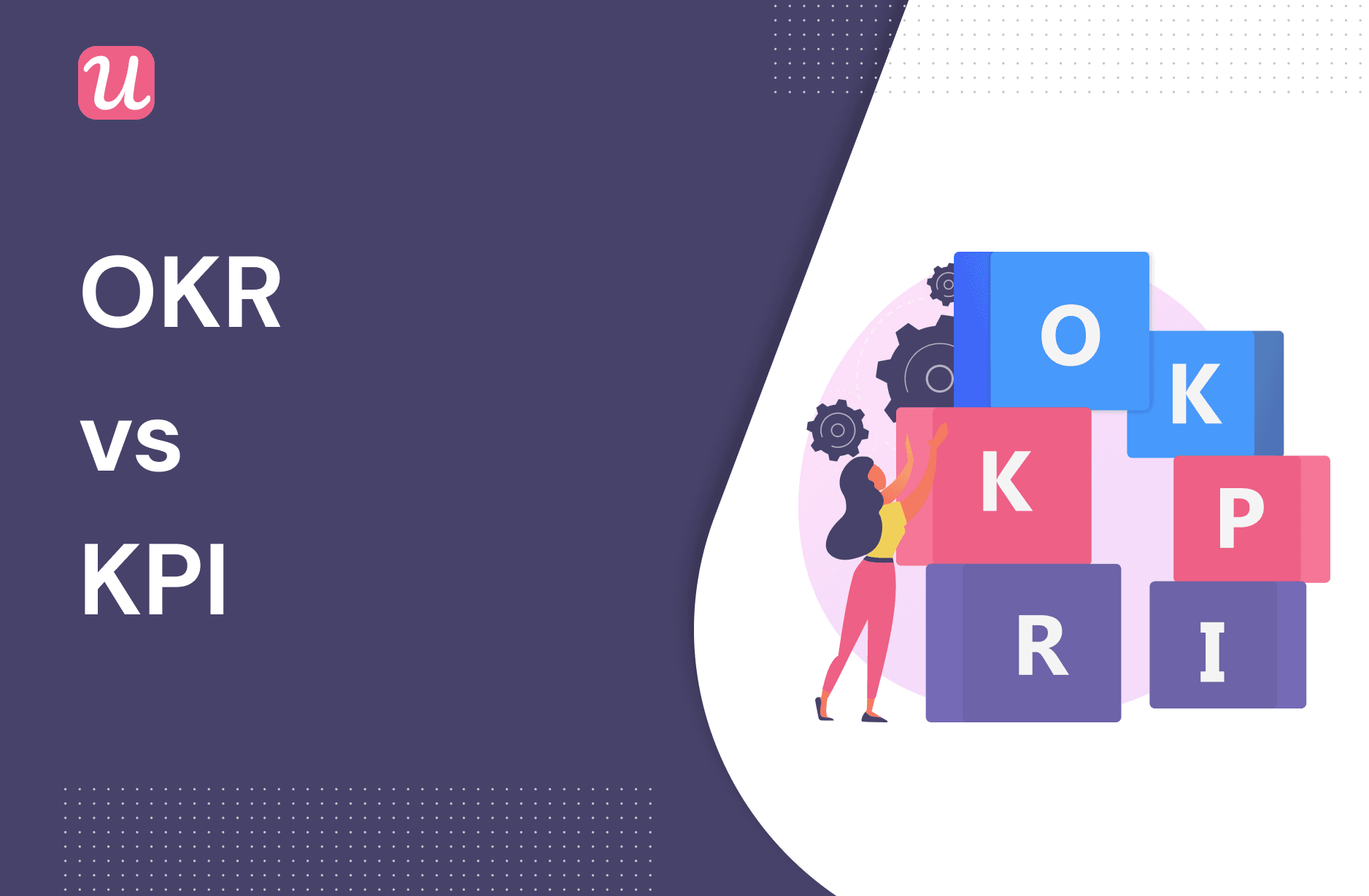
OKRs vs KPIs – Understanding Measurements for your SaaS Product
OKRs vs KPIs – the most recent darlings of the SaaS world. Everyone wants to use them, but a lot of people tend to confuse what they are for and how to actually implement them properly. How do they compare to metrics? Are they the same thing? Let’s find out!
To get you started in the right direction, let’s look at what these two concepts are about, how and when to use them, and answer some common questions in a brief Q&A.
Get The Insights!
The fastest way to learn about Product Growth, Management & Trends.
What are OKRs?
OKR stands for objectives and key results, and their main goal is to help give your team focus.
Objectives are always linked to the company’s larger vision and mission. They help you understand the impact that your work is having. Above all, they are outcome-focused and key results always measurable.
This means that you’re trying to move the needle up or down in some way by working on projects that will help you achieve that end goal. Keeping something static (like keeping a metric at a particular number) is not a key result.
I will give you two OKR examples, one real-world and the other business-based:

Now that you have the end goal you want to achieve, and a measurement for where you want to be when you do the work, the set OKRs provide you with an overall direction and focus for your team.
Next, you have to define what you could possibly do in order to hit those key results. These are called initiatives, and they revolve around problems to solve in order to achieve the desired outcome.
Let’s take the above OKR examples again:
Real-world example:
- Objective: Reduce body fat %
- Key result: Reduce body fat by 5% by the end of the year
- Initiative: Run 5K twice a week
The plan here in order to reduce body fat is to run 5k twice a week. That is how we hope to reach our desired outcome.
Business-based example:
- Objective: Grow user base
- Key result: Grow user base by 25% by the end of Q4
- Initiative: Optimize in-app onboarding
The plan here in order to grow our user base is to optimize in-app onboarding in order to reach that 25% by the end of Q4.
What are KPIs?
KPI stands for key performance indicators, and they are a way for you to understand the performance against the key results that you have set.
Let’s tap into our examples again and look at how we might understand performance with a KPI example added:
Real-world example:
- Objective: Reduce body fat %
- Key result: Reduce body fat by 5% by the end of the year
- Initiative: Run 5k twice a week
- KPI: Run 2k every week
Let’s be honest, if you have never been a runner, how can you expect to just get up and hit 5k?
You can’t, so you need to set certain indicators to help you understand that you’re moving in the right direction. These metrics then help you gauge whether or not you’re at risk of not hitting that final desired outcome.
Business-based example
- Objective: Grow user base
- Key result: Grow user base by 25% by the end of Q4
- Initiative: Optimize in-app onboarding
- KPI: Monthly Recurring Revenue is increasing steadily by 5%
Much like our real-world key result, performance metrics are set in order to understand if we’re close to achieving our end goal to grow our user base by the end of the set quarter. If you are falling behind, then it’s an indicator that you could be looking at potential other problems to solve in order to improve performance.
OKR vs KPI vs Metrics – spot the difference
Metrics are another level of tracking that organizations often get confused about. They are not the same as objectives and key results or key performance indicators, but still help you keep track of things on a different level.
Let’s recap all this for a quick second:
- Objective: Desired, measurable goal
- Key result: The impact that your work has towards achieving the objective
- Key performance indicator: How you’re doing in terms of success in order to reach that result
- Metric: Data that you can track and use to uncover a potential problem
Another way of thinking about this is: Every organization’s KPI is a metric, but not all metrics are KPIs.(Check out these KPI examples by the Userpilot team!)

So while your objectives, key results, and KPIs are all there to help you measure success, metrics, in general, are there to help you keep an eye on things on an ongoing basis so that you are able to prevent things from slipping through the cracks.
If a metric is in danger, you can use it to uncover a problem to solve.
I see a lot of companies tracking customer satisfaction as a key result, wanting to achieve above 90% in satisfaction metrics. The question here is – should that really be a key result, a key performance indicator, or is it just a metric?
Well, it really depends.
What is your current objective? If there is a clear problem you need to solve, and your outcome is to increase customer retention, then perhaps making sure you increase customer satisfaction is something you want to achieve if there’s clearly an issue with performance on that front.
In other words, if there isn’t a clear problem here, then it’s very likely what you are doing is falling into the trap of vanity metrics and key results.
Common SaaS Product KPIs and OKRs
OKR and KPIs are very subjective and dependent on what your particular focus is, so it’s difficult to say that there are standard ones across different softwares.
What will affect your measurements are:
- Current product growth and maturity – are you in a startup? Are you in a scale-up? Are you in an Enterprise? All these things matter.
- What are you currently wishing to achieve? What are your current outcomes?
- The industry is something you absolutely need to consider. A SaaS focused on hiring and recruitment won’t necessarily have the same outcomes as a startup focused on customer success software.
There are however some commonalities that can be found. Everyone wants to focus on increasing growth, reducing churn, and expanding their market share. One could argue those are “common” objectives, but how you frame the objective itself is what will change from company to company and product to product.
For example:
If reducing churn is your current focus, you might make it different than another company by setting a limit on how long you are tracking reduction of churn and what your key result might be.
In other words, your structure might be:
Reduce Churn by 10% in Q2
Just because this is your current focus, doesn’t mean another company will have the exact same focus. How you choose to get there will also vary, as it is based on the specific opportunities you now have to achieve said goal.
I generally recommend you change the focus from finding metrics everyone else is using, to metrics that will help you understand how to best solve problems.
DOs
- Make your objectives, key results, and performance metrics quantifiable and measureable.
- Focus on the outcome, not the output.
- Stick with them! It’s tricky to get them right the first or even the second time around. It’s a learning process, nobody gets it right the first time.
- Understand that it is subjective to your team, product, and industry.
DON’Ts
- Don’t be general or vague. Be as specific as possible about what you are hoping to learn from the metrics set.
- Copy what others are doing – remember this is about your own set of goals.
- Don’t set too many OKRs at once. Remember they are meant to help you set focus. If you have too many, your focus will be spread.
Q&A
Below are some common questions I get about OKRs, KPIs, and metrics. Let’s do some myth-busting!
Should OKRs be set on the team level or the individual level?
Always on the team level! You are not competing against each other. You’re a team, this is not an individual race. It makes sense to set this up so that the whole team is contributing towards the company strategy and set outcomes. Goal setting and goal management always start at the top and trickles down – but not all the way down to the individual, but to the team.

Companies also run the risk of adding unnecessary pressure on the individual to hit certain numbers and use it as a way to gauge individual performance. OKRs are not there to monitor a person, they are a process set to give your team focus. Two entirely different things!
What things should I be tracking?
There is really no easy way to answer this. It’s all about outcomes and context. (Lucky for you, the Userpilot team does have some advice around metrics to track!)
For mobile apps, you can create intuitive KPI dashboards to get clear insights into user behavior, engagement, and retention.
Always start with your strategy and vision, then your OKRs, and finally your KPIs. Metrics are there to help you uncover potential problems, but you don’t need to have metrics for literally all the things.
Think of metrics as a way to understand the overall health of your company, while OKRs and KPIs are helping you understand the success of your teams.
Do all teams need to have OKRs?
Myth alert – absolutely not. It is not necessary for all teams to have OKRs forced on them, particularly if they don’t fit the current company or product objectives.
Teams often find themselves under pressure to have OKRs because the company mandates them, but if the current company strategy is to update infrastructure, would your sales team really have an OKR for that? It’s likely not.
You don’t need to have an OKR to prove that your team is working.
Is there an OKR that is better than the other?
I see people comparing OKRs a lot. One thing to keep in mind is that there is no OKR that is better than another, this is about focus, intention, and direction. Good OKRs are measurable and outcome-focused.
For the most part, most companies have very similar objectives, like increasing the conversion rate or increasing market share. What key results and what KPIs you use to then measure the success of that will vary, as these trickle down from the executive level onto the product and various teams.
Should I always hit my OKRs 100%?
Absolutely not. OKRs are about organizational strategy, not about performance. They’re about success, and above all, they’re there to push you to reach a goal. Best practice indicates that you should aim to reach about 50%-70% of your set key results. If you get to 100%, you could use to be more ambitious next time.
If you want to find a code-free solution to help hit your KPIs, get a free demo Userpilot for an easy, breezy experience!






